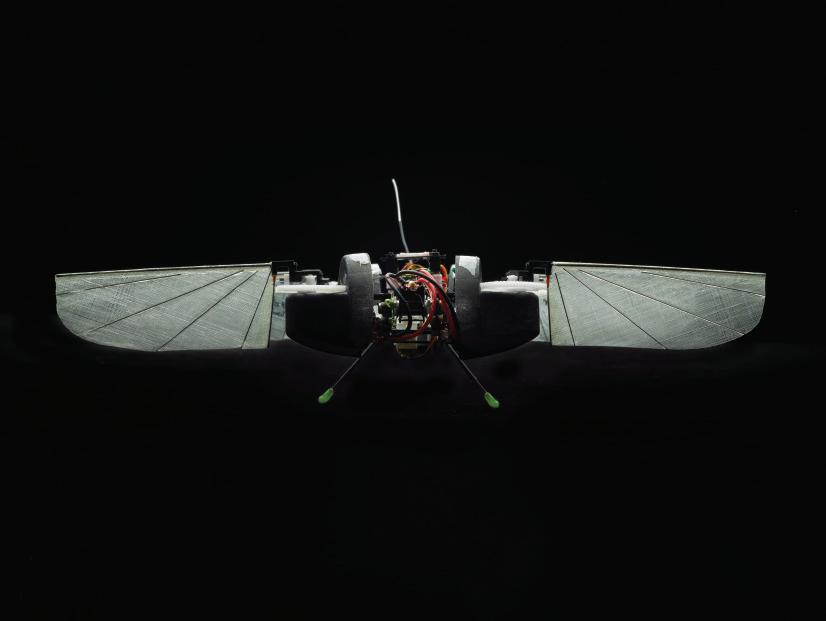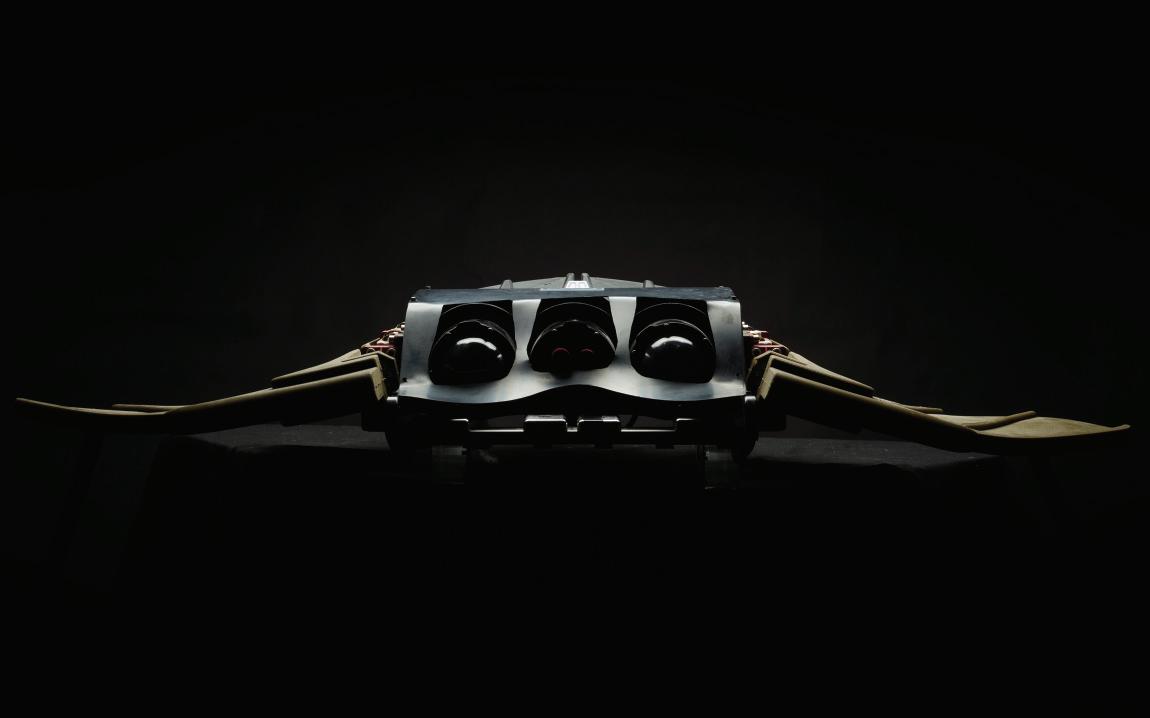
10 minute read
Q&A Paul Topping, Business Development Director, Animal Dynamics
Transforming the genius of nature into battle-ready UAVs
As the crisis in Ukraine unfolds, we are witnessing a fundamental shift in the way land battles are fought. The traditional means of dropping off materials to forward operating bases is an ineffective strategy for resupplying small groups of soldiers in isolated regions. Animal Dynamics Limited which specializes in developing intelligent autonomous drones inspired by the movement of nature, has designed unmanned aerial vehicles (UAVs) capable of delivering materials directly to the combat zone. We reached out to Paul Topping, Business Development Director for the UK-based company, for further enlightenment on this method of distributed logistics.
Crispin Littlehales, Executive Editor, Satellite Evolution Group
Question: What prompted the formation of Animal Dynamics and how has the company evolved?
Paul Topping: The Ministry of Defense (MoD) and the Department of Defense (DoD) were interested in the work that Professor Adrian Thomas, our Chief Science Officer, was doing regarding the general flight dynamics of birds of prey and the way they homed in on their targets. Because it is rather difficult to engage with the military while in a university environment, Professor Thomas and Alex Caccia founded this company in 2015. We started out as a kind of research house for the first five years, but about two and a half years ago, we began to focus on making things that we could get into the hands of users. We went from scientific experimentation to building products, with our CEO Kevin Allington helping to propel the company forward as we edge closer to full-scale commercial deployment.
Our first project was “Skeeter”, a flapping wing, 150-gram UAS nanodevice that was able to fly in 20 knots for 20 minutes. We worked on that for several years and then just kept rolling. As we were perfecting Skeeter, we were approached by the military to create other navigation devices and things that borrow ideas from nature like the general capabilities that animals have, such as movement and resilience.

Skeeter
Photo courtesy Animal Dynamics
Question: Tell us more about your products and what went into the design process.
Paul Topping: For Skeeter, the premise was that Professor Thomas had done a lot of work on efficiency and he could see that, in theory, flapping wings on small devices were more efficient. We went through a huge process of different mechanisms to generate the flapping, borrowing the kind of energy return that these insects have, and the flexibility in the wings to react to gusts and other things. So, he took the information from research papers and turned that into an effect on the vehicle itself. For example, if Skeeter experiences a gust of wind, its wing will shift sideways, generate lift, and shift around, almost like a car’s suspension. We can also actively measure turbulent air and react on the back wings before the wind hits the front ones. That’s why Skeeter can stay in the air so well. Moreover, a typical counter unmanned aerial system (C-UAS) radar will detect a bunch of rotors, but it won’t hear flapping wings because those are a lot quieter, and they have a different profile.
The same is true for the Raydrive, our underwater autonomy system inspired by the motion of a manta ray which has very slow, forceful flapping. The Raydrive, like the manta ray, pushes itself along underwater using a propulsion technique that enables it to glide using minimal energy. Systems designed to find an autonomous underwater vehicle will be looking for spinning propellers, not very slow, gentle flapping.
The Stork STM vehicle, our autonomous heavy lift parafoil capable of carrying 135kg over 400km is super-resilient. The inspiration came from the bird strikes that we get on the office windows. The birds hit the glass and fall to the ground, but then they fly again. We designed the Stork family of vehicles to have that kind of resilience. When users overload them and mistreat them, they’ll typically survive. If they are damaged, users can easily fix them without the need for specialized tools.
This is true for the other products as well. You can stick your fingers into Skeeter’s flapping wings, and it won’t hurt them. The vehicle will still fly even after bumping into trees or walls. You can bury the Raydrive in the seabed and it will swim back out again. The resilience of these systems is a property that makes them fit for use in the applications we are targeting.

Raydrive
Photo courtesy Animal Dynamics
Question: How are your systems deployed and controlled?
Paul Topping: We are trying to make fully autonomous systems so that they are resilient to GPS jamming and comms jamming. We have a local mesh radio capability and there is satcom as well. We also use LTE for other situations.
The Stork STM has a satellite link, and we have the slightly unusual situation where it is launched by one party and then received by another so there are different people communicating with the device. We’ve installed different systems for doing that. We are making it build into standard A-Tech systems as well as being able to direct it by voice.
It is controlled much like a traditional drone with waypoints at height and position where we can send other commands for dropping payloads. If you’re trying to either look at something or drop something and you don’t want to give away position, we’ve got an 8-to-1 glide ratio, so we can climb too high, just glide down, drop something, glide away, and then power up the engines again. That way, we can be nice and stealthy.
Question: Can you explain what “distributed warfare” and “distributed logistics” are and tell us how your products fit into that? Also, how does the Stork STM take humans out of dangerous situations?
Paul Topping: There was a program in the US that looked at the kind of problems involved in moving small items around in an IED-laden environment and how ariel logistics might handle that. We realized that they were describing a battlefield situation that wasn’t traditional. Rather than the kind of Wild West wagon train 100 truck long resupply missions where supplies go from a logistics hub to a forward operating base and then on to the squads at the front, they were thinking about airdrops. This is because modern wars, like the one we have seen unfolding in Ukraine, involve lightweight devices capable of taking out big assets at long range. This means that you have pockets of fighting by squads that get cut off.
That prompted us to envisage a solution where you have one safe location 200 kilometers back from the fighting where you use an unmanned vehicle like the Stork to carry fuel or supplies to the very area where they are needed. The Stork can operate, day or night, in environments where normal humandriven craft cannot work. Also, once you take the human out of harm’s way, you can afford to use multiple Storks so that even if one or two are taken out by artillery, the others will get through.
We designed the Stork STM to be able to carry about 300 pounds in a single load. We picked that amount because 98 percent of what usually needs to be moved broke down into units that were smaller than that; so that seemed to be a sweet spot weight-wise. The load just straps onto the vehicle, is winched up, and attaches. We can move medical supplies, including blood because the Stork STM doesn’t have the vibration problem that quadcopters do.
Although we’ve imagined the Stork STM as a way of delivering supplies, you could put a radar or a 5G rebroadcasting system underneath. There has also been some interest in human evacuation, but in the US, you cannot evacuate a person without a second person with them. There is also a personnel infiltration (PI) program in the US, and we’ve looked at that as well, but we’re currently addressing logistics in urgent or dangerous situations.
Question: Are any of your products currently in use on the battlefield? If not, what is the timetable for getting them in place?
Paul Topping: The small Stork (ST-25) has a handful of specialist users, but we honestly don’t know what exactly they are doing with them. That system is fully operational and designed for use in last-mile logistics, infrastructure monitoring, as well as various LIDAR and other surveillance missions. It carries 10kg over 40km and has payload drop capabilities.
In July, we announced a collaboration with the University of Manchester to improve the realism of our simulated environment and accelerate the commercial rollout of the Stork STM. The advanced simulation software is expected to underpin a pioneering flight control system that will improve the UAV’s tolerance by enabling it to respond immediately to changing wind conditions. Currently, they are using a test Stork STM to measure flight data so that we can verify all the simulation work that we’ve conducted. We expect to have representative vehicles available for test at the end of this year.
We are involved in a program here in the UK called Project Theseus which is looking at autonomous ground and air resupply with software systems to control that. We’re also talking with other military operations in the US.
Question: What comes next for Animal Dynamics?
Paul Topping: The Stork STM is very much our focus. The further we get down the path with it, the more its utility becomes apparent. We see how it can save lives, take people out of danger, and aid in humanitarian efforts. It has civilian applications as well. It can be used in agriculture for crop spraying and for firefighting because we can loiter with them and carry relatively modest amounts of fire retardant while getting to hard-to-reach areas quickly.
The Stork STM is modular and repairable but there is a level of sophistication in the autonomy system that has some unusual elements for identifying landing sites and avoiding threats. There are some interesting mechanical challenges like putting a wing up on a vehicle. However, Professor Thomas was UK Paragliding Champion a couple of times and he’s done wing design for a number of the World Championship-winning paragliders, so he has a feel for the pros and cons of different types of wings and balance.
We intend to manufacture the Stork STM in some numbers. We have just taken on a 20,000-square-foot unit to build the first devices and we already have people who are interested in doing live warfighting experiments with them to see what kind of advantages they deliver. It is an inherently safe and resilient design; built for the kind of dirty and dangerous situations that you find on the battlefield or in the middle of a disaster. GMC

Stork STM vehicle
Photo courtesy Animal Dynamics





